
HMS Montclare (F85) was a British ocean liner that was commissioned into the Royal Navy as an armed merchant cruiser in 1939, converted into a destroyer depot ship in 1944 and a submarine depot ship in 1946. She was decommissioned in 1954 and scrapped in 1958.
SS Chenab was a steamship that was built in England in 1911 and scrapped in Scotland in 1953. For nearly two decades she was part of Nourse Line, which carried Girmityas from India to colonies in the Caribbean and the Pacific. In 1914 she was requisitioned for service in the First World War.

Megantic was a British transatlantic ocean liner that was built in Ireland and launched in 1908. She was one of a pair of sister ships that were ordered in 1907 by Dominion Line but completed for White Star Line.

HMS Forfar (F30) was a British ocean liner that was commissioned into the Royal Navy as an armed merchant cruiser in 1939 and sunk by enemy action in 1940. She was launched in Scotland in 1920 as a transatlantic liner for the Canadian Pacific Steamship Company as Montrose. She was one of three sister ships. The others were Montcalm, also launched in 1920, and Montclare, launched in 1921.
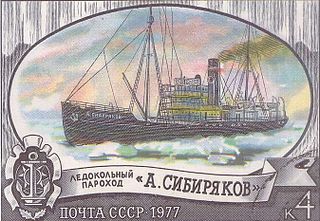
Alexander Sibiryakov was a steamship that was built in Scotland in 1909 as Bellaventure, and was originally a seal hunting ship in Newfoundland. In 1917 the Russian government bought her to be an icebreaker. She served the RSFSR and Soviet Union until 1942, when she was sunk by enemy action. The ship gave notable service in the Russian Arctic during the 1930s.

Belgenland was an iron-hulled sail-steamer that was launched in England in 1878 and spent most of her career as a Belgian transatlantic ocean liner. She was renamed Venere in 1904 and scrapped in Italy in 1905.

Komagata Maru was a cargo steamship that was built in Scotland in 1890, was in German ownership until 1913, and then had a succession of Japanese owners until she was wrecked in 1926. She was launched as Stubbenhuk, renamed Sicilia in 1894, Komagata Maru in 1913 and Heian Maru in 1924.

SS Statendam was a transatlantic ocean liner that was launched in Ireland in 1898 for Holland America Line. She was the first of several ships in the company's history to be called Statendam. She was NASM's first ship of more than 10,000 GRT, and she was the largest ship in the company's fleet until Potsdam was completed in 1900.
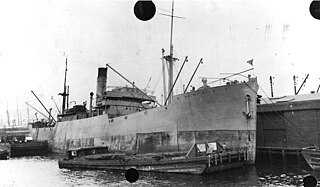
USS Craster Hall (ID-1486) was a cargo steamship that was built in Scotland in 1909 and served in the merchant fleets of first the United Kingdom and then the United States. From 1918 to 1919, she served in the United States Navy. In 1927, she was damaged in a collision off the coast of Peru, was beached to prevent her sinking, but was wrecked.
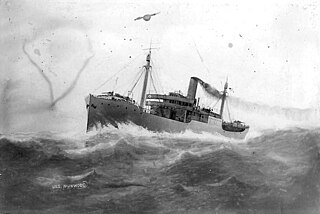
USS Munwood (ID-4460) was a cargo steamship that was built in Scotland in 1914 and was part of the United States Merchant Marine until 1928. From 1918 to 1919 she served in the United States Navy. In 1928 Yugoslav interests bought her and renamed her Vila. In 1935 she sank as the result of a collision in the Adriatic Sea.

SS Polar Chief was a merchant steamship that was built in England in 1897 and scrapped in Scotland in 1952. In her 55-year career she had previously been called Montcalm, RFA Crenella, Crenella, Rey Alfonso, Anglo-Norse and Empire Chief. Early in the First World War she spent eight months pretending to be the battleship HMS Audacious.
Ramón Alonso R. was a merchant steamship that was built in Scotland in 1898 and scrapped in Spain in 1959. Her original name was Montclair. She was renamed José Gallart in 1901, Balmes in 1911 and Ramón Alonso R. in 1929. Her first owner was the British Elder Dempster Lines, but she spent most of her career with a succession of Spanish owners. She was built as a transatlantic ocean liner with some cargo capacity, but in 1927 she was refitted as a cargo ship. In 1913, when she was called Balmes, the ship survived a serious cargo fire in mid-Atlantic.

HMAS Grantala was a passenger steamship that was built in England in 1903 as a coastal interstate liner for the Adelaide Steamship Company. In 1914 the Commonwealth government requisitioned her as a Royal Australian Navy hospital ship.
City of Belfast was a passenger steamship that was built in England in 1893, renamed Nicolaos Togias in 1925, renamed Kephallinia in 1933 and sank in 1941. She was owned and registered in Britain until 1925, when she passed to Greek owners.

City of Bradford was a British passenger and cargo steamship that was built in Yorkshire in 1903, renamed Donau in 1916, reverted to City of Bradford in 1919 and became Hanne in 1936.

SS City of Leeds was a British North Sea passenger and cargo steamship that was built in Yorkshire in 1903 and scrapped in Northumberland 1937. In the First World War the Imperial German Navy captured her and used her as a depot ship.
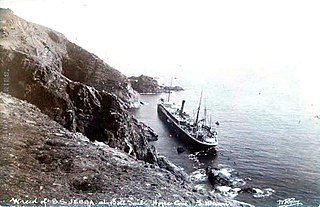
SS Jebba was a steamship that was built in Middlesbrough in 1896 and wrecked on the south coast of Devon in 1907. She was launched as Albertville for the Compagnie Belge-Maritime du Congo (CBMC), and was renamed Jebba when Elder, Dempster & Co acquired her in 1898. She was the first of four CBMC ships to be called Albertville, and the first of two Elder, Dempster ships to be called Jebba.

SS Grampian was a transatlantic ocean liner that was built in Scotland in 1907 and scrapped in the Netherlands in 1925. She was operated originally by Allan Line, and later by Canadian Pacific Steamships. In the First World War she remained in commercial service but carried Canadian troops. In 1919 she survived a collision with an iceberg. In 1921 she was gutted by fire while being refitted. The refit was abandoned, and in 1925–26 she was scrapped.
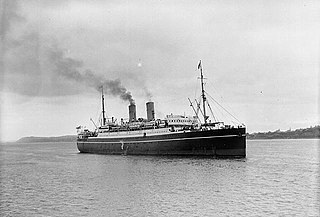
SS Metagama was a transatlantic ocean liner That was launched in 1914 and scrapped in 1934. The Canadian Pacific Railway Co owned her and the Canadian Pacific Steamship Co operated her. She was a pioneering example of a "cabin class" passenger ship.

SS Rio Tercero was a cargo steamship that was launched in England in 1912 as Eboe. She was renamed Fortunstella in 1938, and Rio Tercero in 1941. A U-boat sank her in the Battle of the Atlantic in 1942.


















